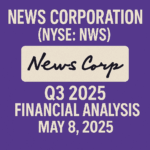GameStop Corp. (NYSE: GME)
Q2 2025 Financial Analysis | September 10, 2025
Executive Summary
GameStop delivered exceptional second quarter 2025 results, demonstrating strong operational performance and strategic progress. Net sales increased 22% to $972.2 million, driven by robust growth in hardware and collectibles segments. The company achieved a remarkable turnaround with operating income of $66.4 million compared to an operating loss of $22.0 million in the prior year. GameStop’s balance sheet remains exceptionally strong with $8.7 billion in cash and cash equivalents and $528.6 million in Bitcoin holdings, positioning the company for strategic investments and long-term growth.
Q2 2025 Highlights
Financial Performance
GameStop’s second quarter 2025 results reflect a transformative period in the company’s evolution, with net sales increasing 22% to $972.2 million compared to $798.3 million in the prior year quarter. This robust growth was driven by strong performance across multiple segments, particularly in hardware and accessories, which benefited from new console launches and increased consumer demand.
The company achieved a remarkable operational turnaround with operating income of $66.4 million compared to an operating loss of $22.0 million in Q2 2024. This improvement was driven by both revenue growth and significant cost management initiatives, with SG&A expenses decreasing 19% to $218.8 million from $270.8 million in the prior year.
Net income surged to $168.6 million ($0.31 per diluted share) from $14.8 million ($0.04 per diluted share) in the prior year quarter, representing a 1,039% increase. This exceptional performance was supported by strong operational results, significant interest income from the company’s substantial cash position, and a $28.6 million unrealized gain on digital assets.
Gross profit increased 14% to $283.1 million, though gross margin compressed slightly to 29.1% from 31.2% in the prior year. This margin pressure reflects a shift in product mix toward hardware and accessories, which typically carry lower margins but higher absolute dollar contributions.
The company’s six-month performance was equally impressive, with net sales essentially flat at $1.7 billion but a dramatic improvement in profitability, with net income of $213.4 million compared to a net loss of $17.5 million in the prior year period.
Product Category Performance
| Product Category | Q2 2025 Sales ($M) | Q2 2024 Sales ($M) | YoY Change | % of Total Sales |
|---|---|---|---|---|
| Hardware and Accessories | $592.1 | $451.2 | +31% | 60.9% |
| Software | $152.5 | $207.7 | -27% | 15.7% |
| Collectibles | $227.6 | $139.4 | +63% | 23.4% |
Hardware and Accessories was the standout performer, generating $592.1 million in sales, a 31% increase from $451.2 million in the prior year quarter. This category now represents 60.9% of total sales, up from 56.5% in Q2 2024. The strong performance was driven by new console availability, gaming peripherals, and consumer electronics demand.
Collectibles showed exceptional growth with sales of $227.6 million, a remarkable 63% increase from $139.4 million in the prior year. This category has become increasingly important to GameStop’s strategy, now representing 23.4% of total sales compared to 17.5% in Q2 2024. The growth reflects the company’s successful expansion into pop culture merchandise, trading cards, and technology enthusiast products.
Software sales declined 27% to $152.5 million from $207.7 million in the prior year quarter, representing 15.7% of total sales compared to 26.0% in Q2 2024. This decline reflects the ongoing industry shift toward digital distribution and the cyclical nature of software releases, partially offset by the company’s digital offerings.
The product mix evolution demonstrates GameStop’s successful diversification strategy, reducing dependence on traditional software sales while building strength in higher-growth categories. The collectibles segment’s growth is particularly noteworthy, positioning GameStop as a destination for pop culture enthusiasts beyond gaming.
Geographic Segment Performance
| Region | Q2 2025 Sales ($M) | Q2 2024 Sales ($M) | YoY Change | Operating Income (Loss) |
|---|---|---|---|---|
| United States | $724.6 | $545.6 | +33% | $63.7M |
| Australia | $140.9 | $87.8 | +60% | $6.0M |
| Europe | $106.7 | $127.2 | -16% | $(3.3)M |
| Canada | $0.0 | $37.7 | N/A | N/A |
United States operations delivered exceptional performance with sales of $724.6 million, a 33% increase from $545.6 million in the prior year quarter. The U.S. segment generated operating income of $63.7 million compared to an operating loss of $1.5 million in Q2 2024, demonstrating the effectiveness of the company’s operational improvements and market positioning.
Australia showed strong growth with sales of $140.9 million, a 60% increase from $87.8 million in the prior year. The Australia segment contributed $6.0 million in operating income compared to an operating loss of $5.9 million in Q2 2024, reflecting improved operational efficiency and market penetration.
Europe experienced challenges with sales declining 16% to $106.7 million from $127.2 million in the prior year quarter. The segment posted an operating loss of $3.3 million compared to an operating loss of $10.4 million in Q2 2024, showing improvement despite revenue pressure.
Canada operations were divested during the second quarter of 2025 as part of the company’s strategic portfolio optimization. In Q2 2024, Canada generated $37.7 million in sales, and the divestiture allows GameStop to focus resources on higher-growth markets.
The geographic results highlight the strength of GameStop’s core North American operations while demonstrating the company’s ability to execute strategic portfolio decisions to optimize profitability and focus.
Balance Sheet & Liquidity Position
GameStop maintains an exceptionally strong financial position, providing significant strategic flexibility and investment capacity:
- Cash and Liquidity: $8.7 billion in cash and cash equivalents as of August 2, 2025, more than doubling from $4.2 billion in the prior year quarter
- Digital Assets: $528.6 million in Bitcoin holdings, demonstrating the company’s commitment to digital asset innovation
- Total Assets: $10.3 billion compared to $5.5 billion in the prior year, reflecting the strong cash position and operational assets
- Long-term Debt: $4.2 billion in convertible debt, providing additional financial flexibility
- Stockholders’ Equity: $5.2 billion, providing a strong foundation for future growth initiatives
The company’s substantial cash position was enhanced by the issuance of $4.2 billion in convertible debt during the first half of 2025, providing additional capital for strategic investments while maintaining operational flexibility. This financing strategy positions GameStop to pursue transformative opportunities while maintaining financial stability.
Working capital management remained strong with merchandise inventories of $484.9 million compared to $560.0 million in the prior year, reflecting improved inventory management and operational efficiency. The company’s accounts payable increased to $292.9 million from $220.5 million, indicating improved supplier relationships and working capital optimization.
Free cash flow for the quarter was $113.3 million compared to $65.5 million in the prior year quarter, demonstrating the company’s ability to generate substantial cash from operations while investing in growth initiatives. The six-month free cash flow of $302.9 million compared to negative $49.2 million in the prior year reflects the dramatic improvement in operational performance.
This exceptional liquidity position provides GameStop with the financial resources to pursue strategic initiatives, invest in technology and digital transformation, expand into new product categories, and return capital to shareholders while maintaining a strong defensive position in uncertain economic environments.
Strategic Initiatives & Transformation
GameStop’s strategic transformation continues to drive operational improvements and position the company for future growth:
Operational Excellence
- Cost Management: SG&A expenses decreased 19% to $218.8 million, demonstrating effective cost control while maintaining growth investments
- Portfolio Optimization: Divested Canadian operations and initiated plans to divest French operations to focus on core markets
- Inventory Management: Improved inventory turnover and reduced inventory levels while maintaining product availability
- Store Footprint: Continued optimization of retail footprint to focus on profitable locations and enhanced customer experience
Digital Asset Strategy
- Bitcoin Holdings: Maintained $528.6 million in Bitcoin holdings, demonstrating commitment to digital asset innovation
- Blockchain Technology: Continued investment in NFT marketplace and blockchain-based gaming initiatives
- Digital Innovation: Enhanced digital capabilities across e-commerce and customer engagement platforms
Product Diversification
- Collectibles Expansion: 63% growth in collectibles sales, establishing GameStop as a pop culture destination
- Hardware Focus: Strengthened position in gaming hardware and accessories
- Technology Products: Expanded offering of consumer electronics and technology products
The company’s transformation initiatives have delivered measurable results, with operating income of $66.4 million in Q2 2025 compared to an operating loss of $22.0 million in the prior year. This improvement reflects the success of cost management initiatives, product diversification, and operational efficiency improvements.
GameStop’s substantial financial resources position the company to accelerate strategic initiatives, invest in emerging technologies, and capitalize on growth opportunities in gaming, technology, and pop culture markets. The company’s focus on operational excellence while maintaining strategic flexibility demonstrates disciplined capital allocation and execution capability.
Risks & Opportunities
Opportunities
Risks
Conclusion
Strengths
- Exceptional revenue growth (+22% YoY) and operational turnaround
- Strong balance sheet with $8.7 billion cash position
- Successful product diversification into collectibles (+63% growth)
- Effective cost management (SG&A down 19% YoY)
- Strategic portfolio optimization with non-core divestitures
Areas to Monitor
- Software segment performance and digital distribution impact
- Gross margin pressure from product mix shift
- Execution of digital asset and blockchain strategies
- Consumer spending trends in discretionary categories
- Competition in collectibles and pop culture markets
Summary
GameStop delivered outstanding second quarter 2025 results, demonstrating the successful execution of its strategic transformation. Net sales growth of 22% to $972.2 million, combined with a remarkable turnaround to operating income of $66.4 million, reflects the company’s operational excellence and strategic positioning.
The company’s exceptional cash position of $8.7 billion provides unparalleled strategic flexibility to invest in growth initiatives, pursue strategic acquisitions, and return capital to shareholders. The 63% growth in collectibles demonstrates successful diversification beyond traditional gaming, while the 31% growth in hardware and accessories shows strength in core gaming markets.
While the software segment faces headwinds from digital distribution trends, GameStop’s diversification strategy has proven effective in offsetting these challenges. The company’s focus on operational efficiency, evidenced by the 19% reduction in SG&A expenses, demonstrates disciplined execution alongside growth investments.
Looking ahead, GameStop is exceptionally well-positioned with its strong financial foundation, diversified product portfolio, and strategic focus on high-growth categories. The company’s transformation from a traditional gaming retailer to a diversified technology and pop culture destination appears to be gaining traction, supported by strong operational metrics and financial performance.

